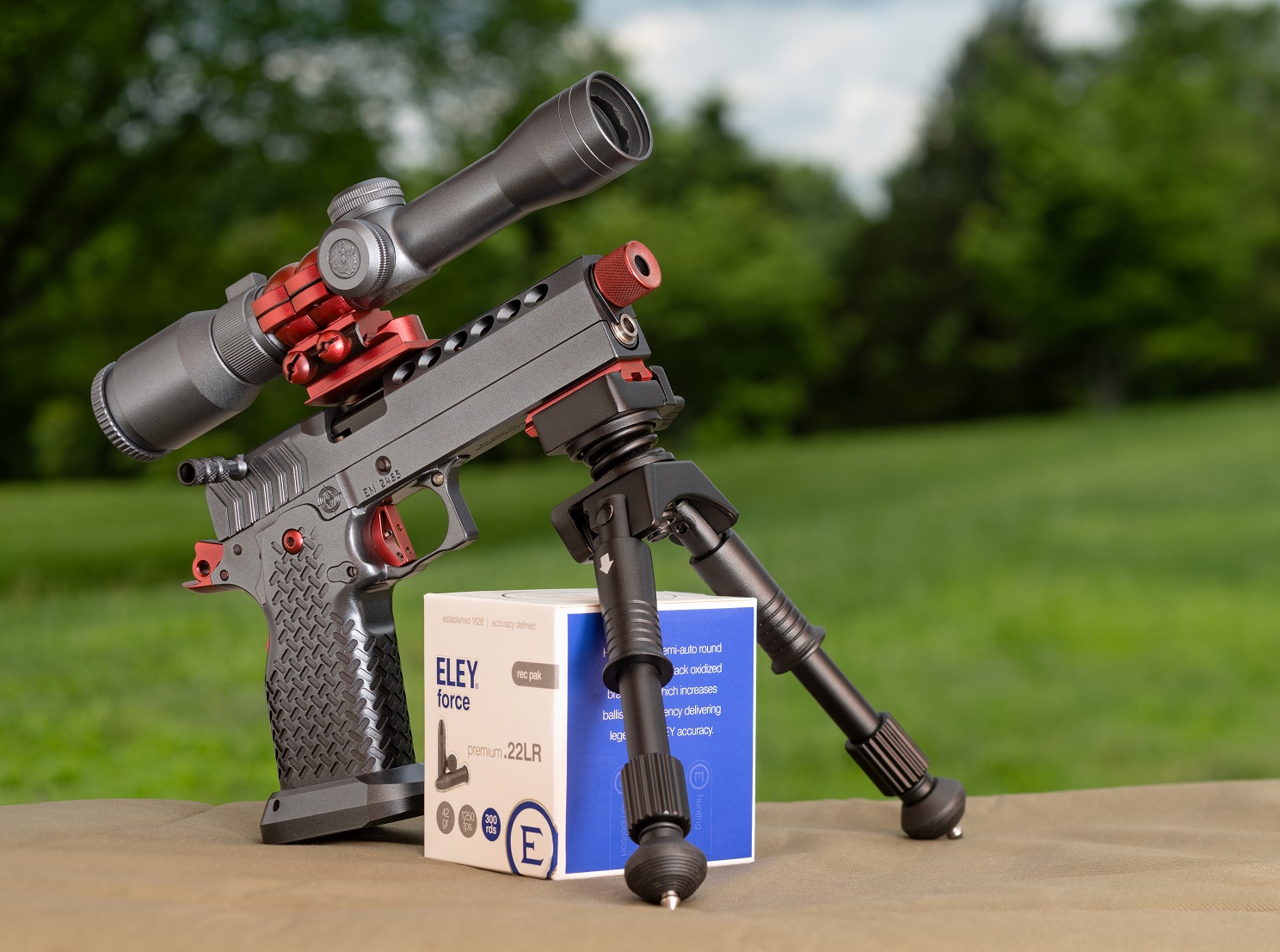A good recipe for long-range hits with a pistol: A CWA custom racegun, a Nikon 2.5-8x scope and ELEY Match ammunition.
By Oleg Volk
As the company name indicates, CW Accessories (CWA) started as an aftermarket parts maker by Chet Whistle in 2011. The performance improvement enabled by CWA parts created a demand for custom, wide-body, 2011-style pistols built from the ground up.
Rimfire conversions of M1911 pistols date back to the 1930s with the Colt Ace. A clever design with a floating chamber, it achieved sufficient reliability for U.S. Army use. Designed to save more expensive centerfire ammunition, it also provided a gentler introduction to the art of the pistol than the roaring .45ACP. Since then, most conversions have been simpler, plain blowback slide and barrel kits. More recently, the form factor of the M1911 has been reproduced with the internal mechanisms designed rather differently, such as the Walther 1911-22 trainer. Minor differences in the manual of arms and less than Match accuracy consign those types to practicing rather than to competition. The last option was the economical but well-designed 1911-22 made by GSG in Germany and imported by ATI. This rimfire pistol followed the internal structure of the centerfire pistol fairly closely (other than a counterproductive magazine disconnector) and had the right look and feel. Its reliability was, in large part, provided by the original magazine design.
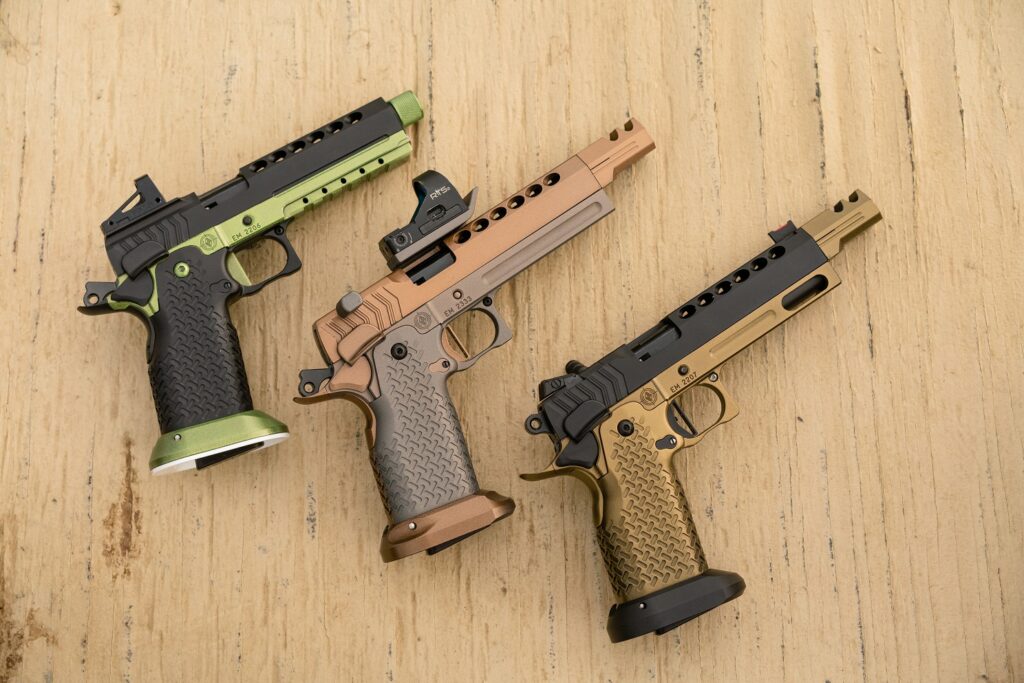
A couple of years ago, I re-trained a friend who learned the basics of shooting 15 years earlier but lacked practice in the interim. Centerfire calibers induced a prominent flinch, so we went through the basics with a BB gun, then tried a variety of .22 pistols. He preferred the GSG 1911-22, putting well over 15,000 rounds through it in half a year. His marksmanship and rapid fire control alike improved by leaps and bounds, but eventually, a broken guide rod sidelined the pistol. Consulting Chet, whose pistols I saw at the Rimfire Challenge World Championship in October 2019, I discovered that this wasn’t a unique event: GSG just made pistols for more casual use than what we needed. While I was trying to get the spare part from ATI, CWA sent their much-improved variant, along with a full re-build kit: a Match bushing, an extractor, an ejector, springs, a titanium recoil spring plug and more precise sights. The difference in the feel and the performance made by those parts was incredible. The balance of the pistol improved due to heavier components up front, which made rapid fire control more reliable. The pistol became less picky on ammunition, now running standard velocity as reliably as high-velocity loads. Most importantly, practical accuracy improved to permit absurdly long-range shooting. Previously, most shooting practice was done inside of 25 yards, and 50-yard shots on a full-size, steel silhouette were challenging. With the upgrade, unsupported 100-yard hits on an 8-inch clanger became routine, with both of us landing 60% to 70% of the shots on it.
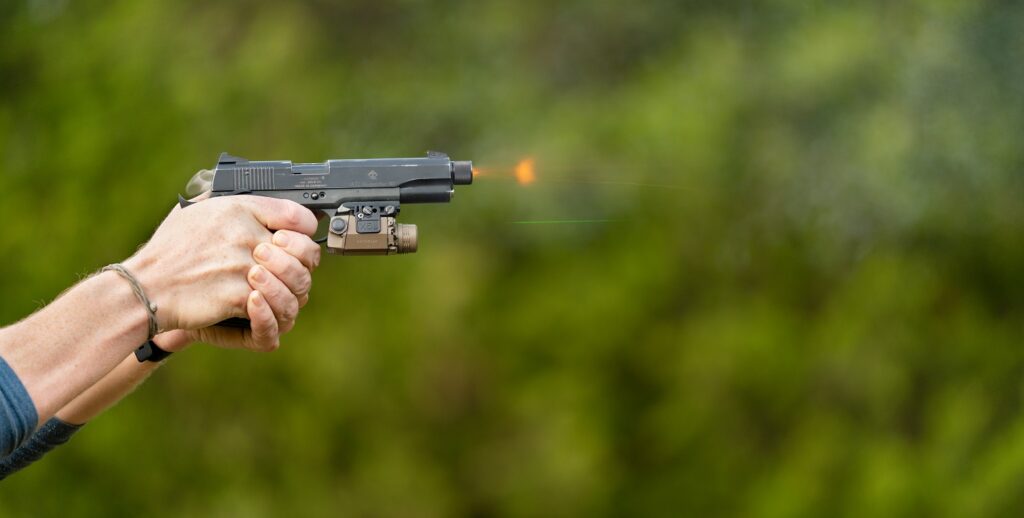
From the Ground Up
With that kind of performance, trying out CWA guns built from the ground up was the next logical step. I’ve seen them on the firing line in competitions and noticed that the users had almost no malfunctions, something that’s quite rare with rimfire raceguns. However, it’s one thing to handle the pistols without firing them and/or watch them in use from the sidelines, and quite another to actually shoot them. Made with grip-frames machined from billet aluminum, CWA pistols are light but very strong. The circumference of the grip built to fit around the excellent GSG magazine is the same as the single-stack M1911. Conversion slides are also available for single-stack M1911 frames. The frame is similar to the 2011 Model, but it doesn’t interchange with centerfire uppers, being optimized from the get-go for the .22LR action. The internal frames are steel for ultimate durability. The 7075 aluminum slides are ported for weight reduction and to promote barrel cooling. Machined with close clearances, all parts move without binding thanks to equally close tolerances and a slick finish. Shooters can pick from a variety of upgraded triggers. Of course, there’s no magazine disconnector to complicate the manual of arms unnecessarily, and there’s no grip safety, so that a light target hold may be utilized for precision shooting.
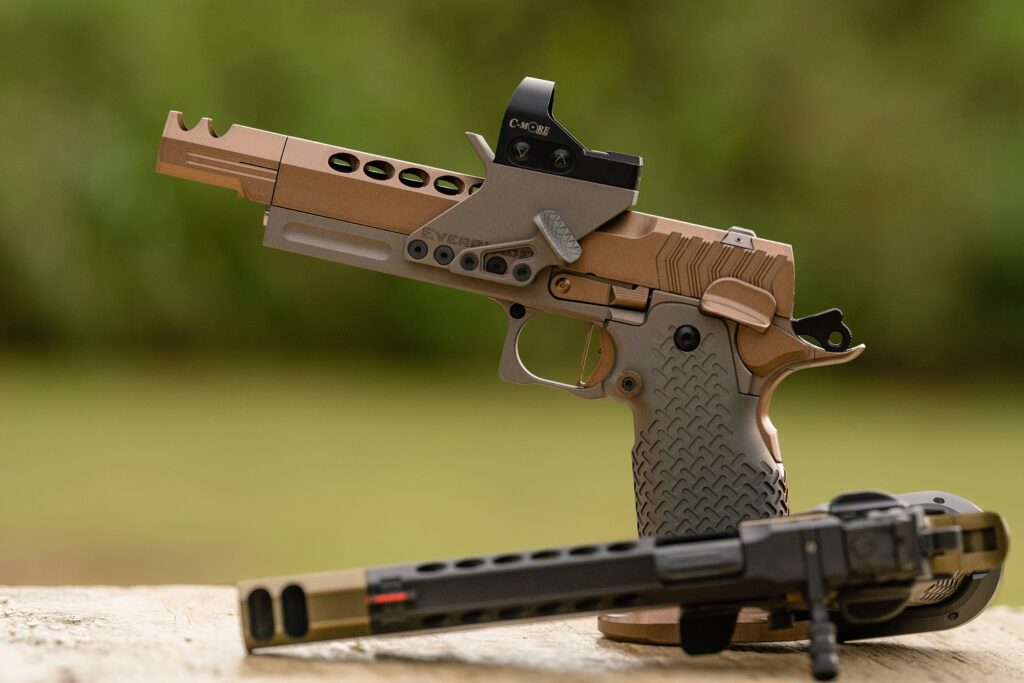
Available in a wide variety of configurations, my sample pistols represented the two extremes: iron sights and magnified optics. The iron-sighted long slide couples a fiber optic front sight with a serrated black rear sight for a very clear and precise aiming picture—8 inches of sight radius on a 6.5-inch barrel make it suitable even for 100-yard targets. An adjustable straight trigger preset at 2.5 pounds makes accuracy easy. Although the pistol looks compensated, the “ports” are decorative. For rimfire steel shooting and other disciplines emphasizing speed, effective brakes are available.

While CWA makes slides cut for micro red dot sights, the optical version I got uses a side mount cantilevered off the frame on the left where it doesn’t block the ejection port. The mount is topped with a short Picatinny rail suitable for a heavier red dot than what the slide would support without compromising cycling, or even a magnified optic. The sample came with a 2.5-8x pistol scope, mainly for testing theoretical accuracy with Match ammunition. The full-length dust cover also sported a rail for a bipod. To get around the dimensions of the hefty optic, the slide came with a right-side charging handle. Since the barrel doesn’t move on firing, it is threaded for a sound suppressor. The pistols are function-tested by CWA with high-velocity ammunition, but they work with standard-velocity ammo as well. With a suppressor, they receive enough additional back-pressure to run reliably with 45-grain subsonics.
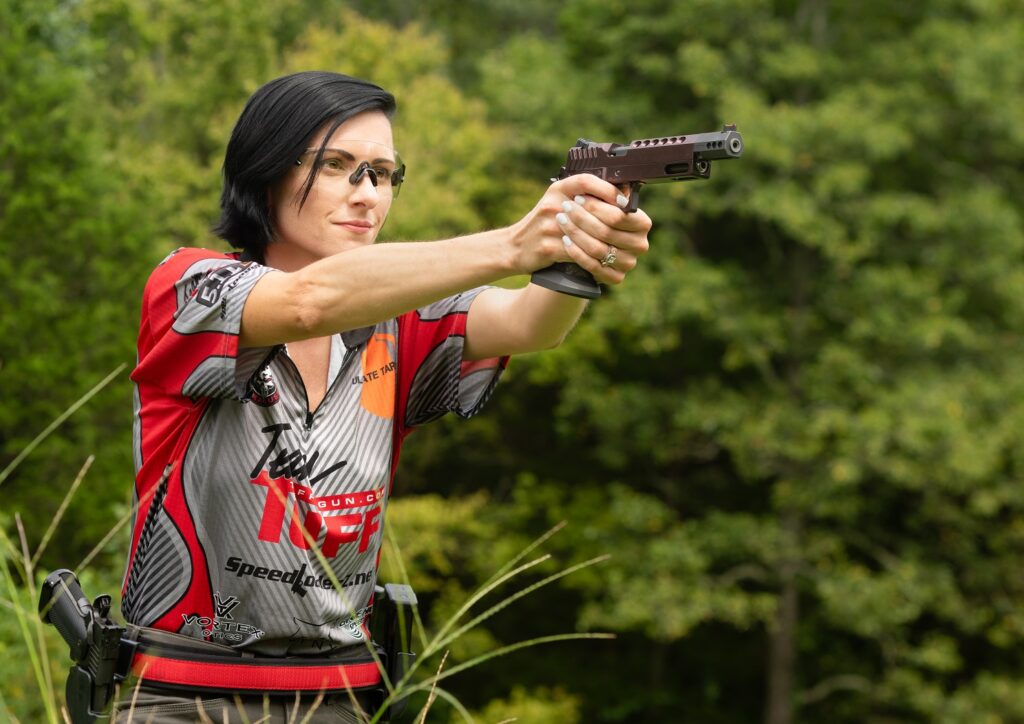
Accurate shooting with an 8 power optic on a pistol is tricky. With a fixed parallax and narrow field of view, keeping a consistent head position becomes critical. Even so, the advantages of a true barrel, ELEY® Match and Federal ammunition, a crisp light trigger and a supported pistol add up. At 100 yards, hitting the 8-inch clanger becomes a certainty. At 25 yards, targets the size of a quarter aren’t safe. For more practical use, a fixed 2x to 2.5x pistol scope or a holographic sight are more reasonable. The side mount raises the line of sight further from the barrel but provides a more stable sight picture without the optic reciprocating on firing. At extended ranges, this works well, while up-close, inside of 15 to 20 yards, a slide mounted MRDS closer to the boreline would be better.
Takedown
Takedown is super simple: Pull the slide half-way back, push the frame pin out to push the slide forward off the frame. The bushing doesn’t require tools, but the slide extension on the longer models is retained with two hex screws—it must be removed before the bushing becomes accessible. The superb fit and finish of the pistols allow them to run with very minimal lubrication. As a result, they don’t get dirty as quickly as most rimfire guns.
Reliable Mags
The magazine is the heart of every auto-loading weapon, and the CWA pistols are no exception. Reliable and consistent feeding is even more critical for rimfires. The standard 10-shot mags disappear under the wide magwell funnels, so CWA offers extended base pads. Two versions are available, standard and +3, and both let the shooter seat the magazine with a quick slap on the bottom.
Get the Win
Equipment by itself doesn’t win competitions. At the same time, between several shooters of similar skill levels, the win will usually go to the one whose pistol is more reliable and ergonomic. That’s the concept of the CWA custom builds: the utmost reliability coupled with the ergonomics, fine-tuned to the individual user. I could observe the improvement in the speed and accuracy on the example of my trainee and in my own shooting as well. On average, I could shoot a course of fire in half to two thirds of the time required for my factory 1911-22 pistols or conversions. That degree of increased speed is worth the effort of commissioning a custom pistol.
| This article first appeared in Small Arms Review V24N10 (December 2020) |



